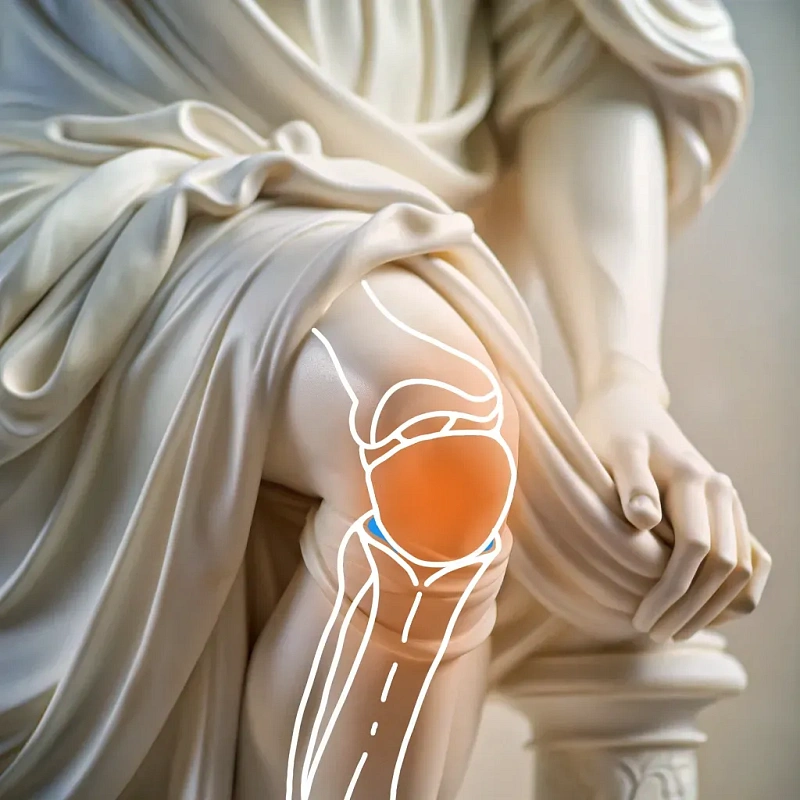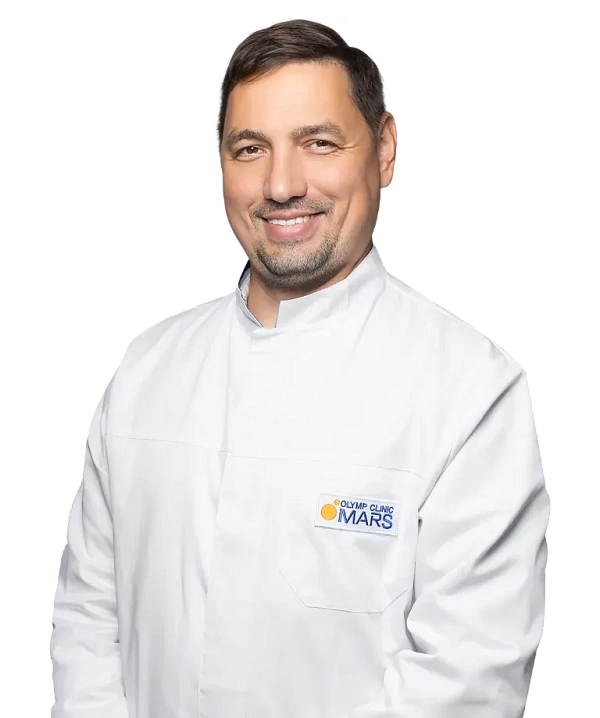Arthrodesis of the joint
This is an operation in which two or more bones in a joint are intentionally fused to eliminate pain and restore function. It is used in the treatment of joints damaged by arthritis, injuries or infections when other treatments prove ineffective.

The main purpose of the procedure is to eliminate pain by creating artificial ankylosis (bone fusion) in a functionally advantageous position. This helps to stabilize the joint, prevent further tissue damage and improve the supporting function of the limb.
The arthrodesis procedure effectively eliminates chronic pain and helps restore the functional activity of the limb, allowing the patient to return to daily activity without restrictions. The procedure also ensures reliable fixation and rapid bone fusion. Arthrodesis of the joint requires careful diagnosis and preparation. After surgery, the patient undergoes a rehabilitation course to restore strength and mobility of the limb.
General blood and urine analysis Coagulogram (assessment of blood clotting) ECG (electrocardiogram) to assess the condition of the heart Radiography of the affected joint Computed tomography (CT) or magnetic resonance imaging (MRI) Consultation with an anesthesiologist to assess the risks of anesthesia
In the early stages of the disease, conservative treatment can be used, including taking painkillers, limiting physical activity and physiotherapy. However, with significant destruction of the joint and severe pain, surgical intervention becomes inevitable. During the operation, the surgeon removes the damaged articular surface and fixes the bones in the correct position using metal plates, screws or pins. This allows the bones to fuse together, forming one solid structure.
Metal plates and screws for secure fixation of bones Imaging systems: X-ray machines and computed tomographs
After surgery, the rehabilitation process begins, including physiotherapy and physical therapy to improve blood circulation, strengthen muscles and restore mobility in the affected area. The rehabilitation process is individual and depends on the general health of the patient and the complexity of the operation.
Frequently Asked Questions
Which joints may be susceptible to arthrodesis?
How long does the recovery after arthrodesis take?
Will the joint be completely immobilized after arthrodesis?
Is it possible to exercise after arthrodesis?
Didn't find an answer to your question?
You can describe your problem in detail and ask a question to the doctor. He will answer you and help you find a solution
Врачи
Смотреть всех врачейDoctor of Medical Sciences, Associate Professor at the Department of Traumatology and Orthopedics of the RUDN. Head of the Center for Arthroscopy and minimally invasive surgery of the joints of the upper and lower extremities.
Orthopedic Trauma Surgeon
Useful information
Olecranon fractures
Olecranon has little or no muscle or other soft tissue protection, making it vulnerable to damage from falls and impacts. The olecranon is the most prominent of the bones forming the elbow joint, specifically the ulna. It attaches to the triceps and, along with the humerus, constitutes the elbow joint, which is responsible for bending and extending the arm. Olecranon fractures vary in complexity. They can be simple, with no displacement of bone fragments, or complex, with damage to the articular surface of the ulna and displacement of fragments by triceps traction. Such fractures cause a loss of extension in the elbow joint, resulting from the disruption of the triceps' connection with the forearm.
Forearm fractures
The forearm is composed of two bones, the radius and ulna, which are connected by a firm interosseous membrane and ligaments at the elbow and wrist joints. Due to their intricate structure, defined by numerous curvatures, these bones constitute five joints. The forearm enables flexion and extension at the elbow and wrist joints, as well as the rotation of the hand (pronation and supination) through the movement of the radius around the ulna.
Rotator cuff rupture
An injury characterized by damage to the tendons that surround the shoulder joint and ensure its mobility.
Impeachment-shoulder joint syndrome
Impingement syndrome (subacromial syndrome) is a condition in which the tendons of the rotator cuff of the shoulder are pinched between the acromion and the head of the humerus, which causes pain and limited movement in the shoulder joint.
Similar referral activities
Arthroscopy of the ankle joint
Ankle arthroscopy is a minimally invasive surgical procedure used to diagnose and treat various diseases and injuries of the ankle joint.
Arthroscopy of the knee joint
Knee arthroscopy is a minimally invasive surgical procedure for the diagnosis and treatment of injuries and diseases of the knee joint. It allows examining the joint for damage and eliminating the identified defects.
Arthroscopy of the elbow joint
Arthroscopy of the elbow joint is a minimally invasive surgical intervention that allows for accurate diagnosis and simultaneous treatment of joint injuries.
Arthrodesis of the joints of the fingers of the hand
The destruction of the joints of the fingers of the hand is accompanied by pronounced pain and impaired functions. Arthrodesis is a surgical intervention in which the affected joint is completely immobilized, which relieves pain and progression of inflammation.
Arthroscopic revision of the cystic joint
The condition of the wrist joints determines the functioning of the hand. Arthroscopic revision is a minimally invasive diagnostic procedure that assesses the condition of the joint tissues, which is necessary for planning subsequent treatment.
Arthroscopy of the shoulder joint
Arthroscopy of the shoulder joint is a minimally invasive surgical procedure designed to diagnose and treat various diseases and injuries of the shoulder joint.
News & Media
All news and mediaIX ASTAOR International Congress: New Solutions in Sports Medicine
On April 4 and 5, 2025, the IX ASTAOR International Congress was held — a large-scale meeting of specialists in the field of sports traumatology, orthopedics, arthroscopy and rehabilitation. Doctors, nurses, rehabilitologists and other professionals from different cities of Russia and the world came to share their practical experience and discuss current injury treatment technologies.
Olymp Clinic MARS has now become an official partner of Peoples' Friendship University of Russia.
Olymp Clinic MARS extends beyond providing high-quality medical care to serve as a comprehensive scientific and educational platform. The clinic will host training events for students, residents, and postgraduates, while physicians will have the opportunity to enhance their qualifications.
Progressive Arthroscopy: The conference in Voronezh welcomed Professor Andrey Korolev as a distinguished guest.
An interregional scientific and practical conference, entitled "Advanced Arthroscopic Treatment in Traumatology and Orthopedics," was held in Voronezh on November 1-2. The event convened over 120 specialists from across Russia, including traumatologists, orthopedists, and rehabilitation specialists.
Andrey Korolev appreciated the launch of the Crew Dragon spacecraft
The first manned spacecraft in almost a decade has been successfully launched in the United States. According to many experts, the launch of the world's first private spacecraft marks a new era in space exploration.
Slipped, fell, woke up — plaster cast: about fracture treatment
A bone fracture is a common injury that almost everyone has been through. Although human bones are very strong, if the external force is too great, they can break like a plastic ruler when it is bent too much. In the article we will tell you how to act in case of a fracture.
Summer injuries: first aid for bruises, dislocations and sprains
Summer is a time for walking, outdoor activities and sports. The sun and warm weather encourage us to spend more time outside and enjoy nature. But the more we move, the higher the risk of injury becomes. It is not surprising that bruises and dislocations become frequent companions of summer leisure. Of course, in case of serious injuries such as fractures, it is necessary to consult a doctor immediately. But what to do with less significant injuries — minor bruises, sprains with slight swelling and pain? In such cases, you can help yourself and others on your own, knowing the basics of first aid. In this article, we will tell you how to cope with injuries sustained during summer activities and quickly return to your usual lifestyle.
What is the danger of flat feet and how to treat it?
Flat feet are an orthopedic problem in which the shape of the foot changes, its longitudinal and/or transverse arch decreases. Normally, the arches of the foot are responsible for cushioning and even distribution of the load when walking and running. But with flat feet, the foot cannot spring properly, which increases the load on the bones, joints and muscles of the legs.
What should I do if my ligaments are damaged?
Ligament damage is an injury in which there is a violation of the integrity of the fibers that make up the ligaments. Ligaments connect bones to each other, stabilizing joints and preventing their excessive movement. They are made up of collagen fibers, which give them strength and elasticity. But under the external influence of the ligament, the length of the ligaments almost does not change, so the fibers can rupture. Ligaments are damaged due to excessive stretching or sudden movement exceeding their normal amplitude. This can happen if you land incorrectly after a jump, fall, abruptly change the direction of movement or a direct blow to the joint.

